Welcome! Go to your Account
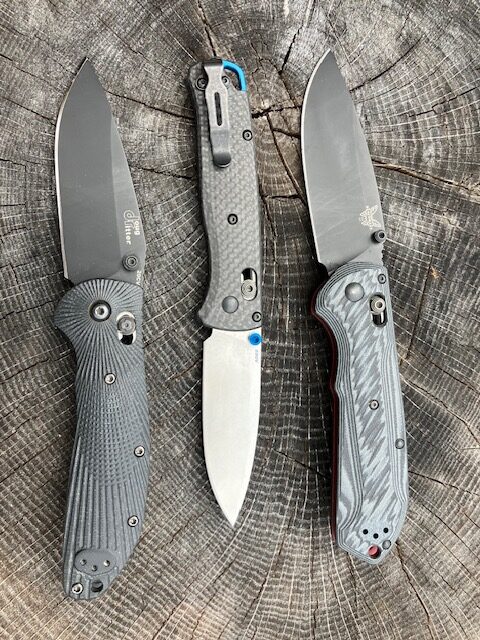
Hey KE’S!
We’ve been working tirelessly behind-the-scenes to try and get the website up and running for you. We really, really appreciate your feedback, so that we can understand what you KnifeEnthusiasts want out there!
I hope to be writing an article every few weeks, and I welcome your feedback to see what else you would like to learn about or rather, just see eye candy!
For our inaugural article, I would like to discuss different types of EDC folding knife locks. We will discuss some specifics, as well as the positives and the negatives. Some things may be objective, and some will be subjective, and I will try to point that out in the article. So, let’s get going!
Selecting a folding knife is a very personal thing. There are a few points to consider:
These are just some examples of parameters that you may want to think about when purchasing a new knife.
Finally, there is the blade lock. Which is what we will be discussing in this article.
There are several different types of locks out there and some are variations, but in this article, we will just be dealing with the most common ones. That means collar locks like the Opinel has, or slide locks like some switchblades used to have, or an extra lever like the CRKT M16, will not be covered in this article.
It should be said that most folding knives have some kind of stopper bar or pin to keep the blade from overextending. Most are sufficient to bear down with some pressure, and while they will keep the blade from hyper-extending, they do nothing to keep the blade from closing forward.
We will be dealing with manually opening knives only. The categories we will be discussing are:
The Slip joint, which is not a true lock, is actually a spring with a lever that holds the blade in the open position. It will not keep it from closing under pressure, but for everyday tasks that do not take a lot of effort they are fine. Examples of this are probably your first jackknife when you were a child, or the famous Swiss Army knife made by Victorinox, or Wenger. As an interesting aside, people always ask me, which is the real Swiss Army knife. The answer is both! They are both under license to make the original Swiss Army knife and both are equal in quality.
The pros are: ease of manufacture, and it is safe enough for everyday tasks. Furthermore, in some municipalities and countries, any type of locking system in a knife is illegal, so the slip joint wins. Its main drawback is that it does not actually lock open, and may close, cutting you in the process if you are not careful. They are still a great option. They just need to be used with care, and are not a first option for a hard use knife.

L Slip joint bone scales unknown Steel, R Victorinox Swiss Army Super Tinker Proprietary Steel
The second category, Back locks, use a lever and a groove or a hook to keep the knife open under load. They are among the oldest types of folding knife locking mechanisms, and they are still around because they are still very good. They are most often found in the middle of the back of the blade, but they could be near the bottom of the knife such as the famous Buck 110. Plenty of the companies out there still use this knife because it is easy to manufacture, and quite effective. The Spyderco Stretch 2 and the cold steel voyager Gunsite are examples of companies that use this lock.
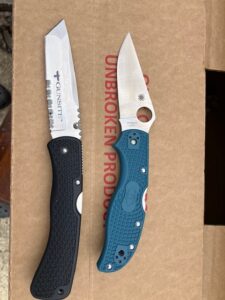
L-R Old style Cold Steel Medium Voyager AUS8, Spyderco Stretch2 in K390
The benefits of this type of lock, is that it is considerably strong for most uses, and it is hard to press accidentally. The drawback is that it is usually a two-hand operation.
It is hard to mention a back lock, without mentioning the Tri-ad lock designed by Andrew Demko and used on many Cold Steel knives as well as the knives bearing his name. There is an extra pin in the system where it locks up which is self-adjusting, and makes for a much stronger back lock. While it is unquestionably, stronger and longer lasting, the drawback is that it takes much more effort to disengage it. If you need extra strength however, it is fantastic! The Cold Steel Code 4 is a good example of this lock!
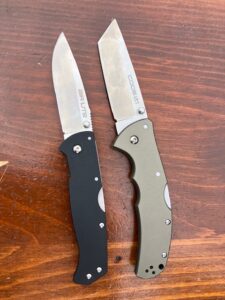
L-R Both Cold Steel, Air Lite in AUS10, and Code 4 in XHP-CTS, new versions are in S35VN
Liner locks, one of my favorite systems, is a spring tempered piece of metal, usually steel, or titanium, that sits in the cavity of where the knife folds. As the knife is opened, it snaps into place, catching the bottom of the blade and keeping it from pivoting.
While not the strongest type of lock, it is adequate for most tasks and will keep the blade open, except possibly under the most extreme conditions. I’ve had friends that have had them fail, but I never have myself. Most companies have a liner lock or two.
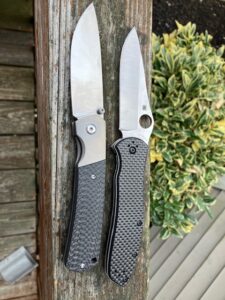
This should be under linerLocks L-R MBK Old Guard CF in ZDP-189 , and Spyderco Gayle Bradly in M4
2 of my absolute favorite EDC‘s the WE Esprit uses the system, as does the Gayle Bradley 2. For most everyday tasks it is up to the challenge.
I would like to say a word about strength, something we will be talking about a lot in coming articles. While it is true that certain locks, handle materials, and knife materials are inherently stronger than others. The problem is, that most people won’t tell you, if something is strong enough.
For example, Frame locks, put more steel or handle material behind the blade. Technically they’re stronger than liner locks, because they are thicker. But if you never need that strength, we are just arguing semantics. Please keep that in mind now, as well as in our coming discussions, moving forward.
The pros are: they are very intuitive to use, and strong enough for most tasks. The cons are: it sometimes messes with the centering in the blade, needs to be dialed in to work properly, and eventually wear and tear will move the position where it locks up on the bottom of the blade. It is also usually made for righties. Being a righty, (Sorry Lefties!) It is overall one of my favorite locks.
Another thing that makes people nervous when discussing liner and frame locks, is that technically you could have a finger in front of the blade channel when you depress the lock to close the knife. But, if you’re careful, you should never have a problem.
When discussing frame locks, simply picture a liner lock that uses the left side of the handle material to lock the blade in place just as a liner lock does. The pros are: It’s much stronger than a liner lock, and keeps extra parts out of the blade channel. The cons are: if it wears out, it’s not as easy to replace as a liner lock, although some smart manufactures such as ZT put a removable piece of metal there, so that it can be changed as it wears. Another issue is that it cuts down on the ability to choose your handle material as it must be some sort of metal. Finally, since they pivot in as the knife is opened, some of them make an uncomfortable hotspot in your hand. Like the liner lock, your finger may be in the way when you disengage the lock, and it is usually made for righties. Other than that, it is one of the better locks I like to use, as it is very intuitive, and strong enough for most tasks!
The ZT 0450 and the Boker Subcom are some examples of this lock.
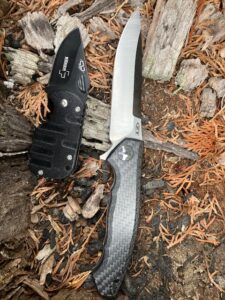
L-R Boker Plus in 8CR13MOV, ZT 0452 Carbon Fiber/Titanium in S35VN
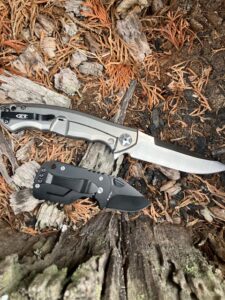
L-R Boker Subcom Plus in 8CR13MOV, ZT 0452 Carbon Fiber/Titanium in S35VN

L-R Boker Subcom Plus in 8CR13MOV, ZT 0452 Carbon Fiber/Titanium in S35VN
Ball bearing locks are awesome! One of my favorites in the house EDC’s the Spyderco Manix 2 has this lock, and as an adult fidget toy extraordinaire! It does not have many equals in my not so humble opinion, but, is similar in some ways to the oft copied Axis lock. We are finally coming onto knives that are ambidextrous, and if the action is good as most are, you can actually open and close the blade without touching the blade, which gives you speed, as well as a cool factor!
It works by pushing a ball bearing with a spring and using it as an anvil to keep the blade open. It is sufficiently strong for most daily use, and as mentioned, ambidextrous. It is accessed by 2 small tabs on either side of the handle material. It has no real drawbacks, except it needs a thumb and a finger to work it, or unless you need something super strong.
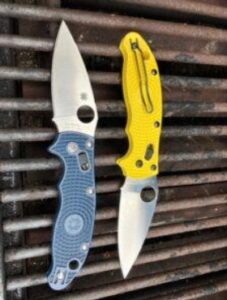
Both Spyderco Manix 2, L S110V R Magnacut
The Axis lock invented by Benchmade and copied by many, took the knife world by storm when it came out. It works on the same principle as the ball bearing lock except it uses a bar instead of a ball bearing. It is one of the best fidget knives out there, and another deployment method where you do not actually need to touch the blade if you don’t want to. It is sufficiently strong for everyday use, however, there are reports of the Omega Springs breaking. It is not the biggest deal to replace, but may lock up the knife until they are. (Hey Benchmade, for what you charge, throw an extra set in with each knife please!) Due to that issue, I would say it’s not as strong as the other locks, including the ball bearing, which uses a captured coil spring, but is still fantastic for most applications. The famous Bugout, uses the system, as well as many other knives who have copied it, such as the Doug Ritter RSK MK series. It is a great option.
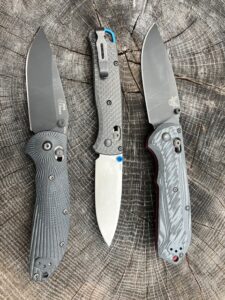
L-R Doug Ritter knife by Hogue in 20 CV, Benchmade Bugout CF in S90 V, and Benchmade SuperFreek in M4
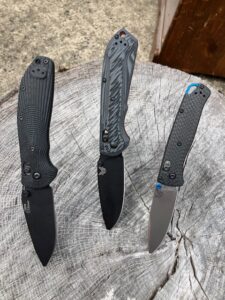
L-R Doug Ritter knife by Hogue in 20 CV, Benchmade SuperFreek in M4, and Benchmade Bugout CF in S90 V
Our last lock for our discussion today is the Compression lock created by Spyderco. It is pretty much like a liner lock, except it is on the back of the knife instead of the front. This gives it the advantage of not having your thumb in the channel where the blade will fall. it is a great design; however, people like myself with large thick hands may have an issue. One of my favorite heavy-duty knives for a while was the Shaman, for which I have three different iterations. The problem I have is because of my meaty paws when I bear down on it, it creates an uncomfortable hotspot in the back of the knife. I really wish, they would make the same exact knife with a different lock, and a solid back. On a light duty knife it is spectacular, unfortunately for a heavy-duty knife where I’m using a lot of pressure, it is very uncomfortable for me.
Examples of these are the aforementioned Spyderco Shaman and the Caribbean.
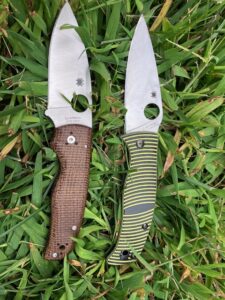
L-R Spydercos Shaman in S90V, and Caribbean in LC200N
I hope you learned something in this article, and enjoy reading it as much as I enjoyed writing it. I am not claiming on this website to provide any innovations, but rather to try to get all of the knowledge that a KnifeEnthusiast would like, into one website so you do not have to keep searching for everything all over the internet. Please let me know if there’s any subjects you would like to learn about in the comment section below, and I would be happy to try to accommodate your request. As I keep telling you; THIS IS YOUR WEBSTITE!!!
I hope this article has been informative, and helpful in making an educated decision of what EDC or number of them you would like to buy! At the end of the day, if you’re reading this, you probably have the fever and will not stop it just one!
Thanks again for reading, checking out our auctions, or options to sell, as well as our forums. We are striving to be YOUR one stop, hang out, for all of you KE’S, that enjoy discussing, buying and selling, or learning about knives.
AJ Eiss